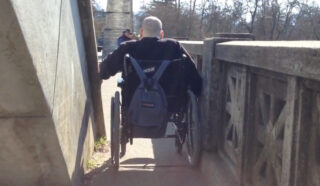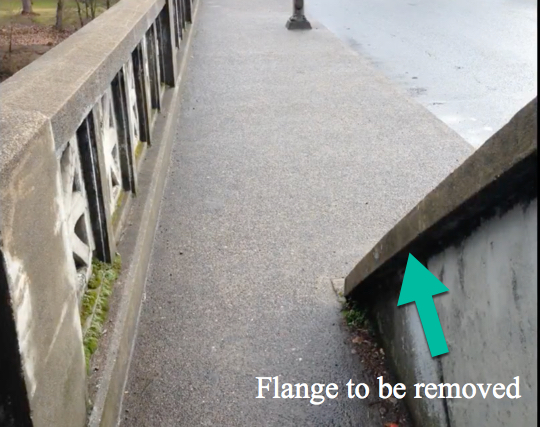
(Screengrab from a video made for HASL Center for Independent Living.)
The ODOT Files is a collection of stories that illustrate how the Oregon Department of Transportation prioritizes auto and trucks users at the expense of everyone — and everything — else.
The Oregon Deparment of Transportation is spending $5.3 million to update and make seismic retrofits to the historic Caveman Bridge in Grants Pass. The project goal is to bring the bridge back to is “Depression era beauty” by repairing cracks, broken concrete, exposed rebar, and delamination of the deck. But for people who use the bridge sidewalk — especially those who use wheelchairs and other vehicles — there’s nothing beautiful about narrow pinch points.
And there was nothing in the plans to widen them until the agency’s hand was forced.
The Caveman Bridge is the main gateway to the Oregon Coast via Redwood Highway (Route 199). It crosses the mighty Rogue River and is a key connection between main street and destinations southwest of downtown. It’s also one of only three bridges in the entire city that crosses the river.
The bridge is admired for its beauty, but for sidewalk users it’s also known as a tight squeeze. Especially for people who use wheelchairs. The narrowest distance between the concrete rail and the swooping arches that spring from the sidewalk is about 31 inches. That’s less than three feet. A standard wheelchair is about 26 inches wide — which leaves just a few inches for hands and arms.
Advertisement

When ODOT began this project in 2016, they considered widening the sidewalk. Local advocates, the Grants Pass City Council, and Disability Rights Oregon all urged ODOT to widen the sidewalk. DRO said a wider sidewalk was necessary, “so that people who use wheelchairs no longer had to endure squeezing through the walkway and risk scraping their knuckles or bumping their elbows.”
But ODOT felt differently. Their project team assessed three options and decided none of them would work after they, “Were determined to have an adverse effect on the historic bridge.”
DRO then continued to push for a wider sidewalk within the constraints of the existing design. Months later, ODOT decided to cut off a decorative flange from the arches that would widen the pinch-point by three inches.

“The city was asking for more, and the disabled community was asking for more,” ODOT spokesperson Gary Leaming told the Grants Pass Daily Courier. “Three inches doesn’t seem like a lot, but it’s going to make a difference.”
Now DRO, an organization that has already won a major lawsuit against ODOT for the agency’s failure to comply with ADA standards on their roads (a recent survey as part of that settlement found that 97 percent of 26,000 curb ramps analyzed weren’t ADA-compliant) is pushing ODOT to review all projects that have requested ADA design exceptions.
“We think the agency should review all projects that were granted a historical exception to the ADA, whether ongoing or completed, and put in place a more rigorous process before granting future exceptions,” DRO wrote in a blog post on March 7th.
Why am I sharing this post on BikePortland?
This is just another illustration of how ODOT gives short shrift to everyone who uses their roads while not inside a car or a truck (my dad also lives a few miles from this bridge and might use a wheelchair himself someday).
— Jonathan Maus: (503) 706-8804, @jonathan_maus on Twitter and jonathan@bikeportland.org
Never miss a story. Sign-up for the daily BP Headlines email.
BikePortland needs your support.

